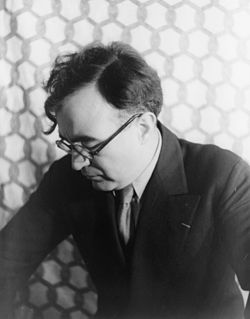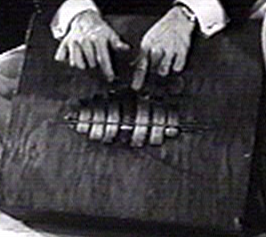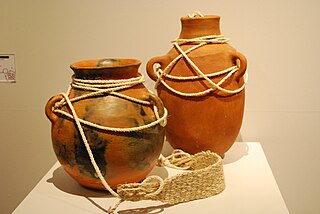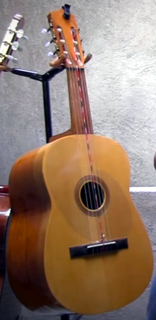Related Research Articles
The term conjunto refers to several types of small musical ensembles present in different Latin American musical traditions, mainly in Mexico and Cuba. While Mexican conjuntos play styles such as norteño and tejano, Cuban conjuntos specialize in the son, as well as its derivations such as salsa.

Carlos Antonio de Padua Chávez y Ramírez was a Mexican composer, conductor, music theorist, educator, journalist, and founder and director of the Mexican Symphonic Orchestra. He was influenced by native Mexican cultures. Of his six symphonies, the second, or Sinfonía india, which uses native Yaqui percussion instruments, is probably the most popular.

Rodolfo Neri Vela is a Mexican scientist and astronaut who flew aboard a NASA Space Shuttle mission in the year 1985. He is the second Latin American to have traveled to space.

The marímbula is a plucked box musical instrument of the Caribbean. In Cuba it is common in the changüí genre, as well as old styles of son. In Mexico, where it is known as marimbol is played in son jarocho; in the Dominican Republic, where it is known as marimba, it is played in merengue típico, and in Jamaica it is known as rumba box and played in mento.

Norteño or Norteña, also música norteña, is a genre of Regional Mexican music from Northern Mexico, hence the name. The music is most often based on a polka or waltz tempo and its lyrics often deal with socially relevant topics, although there's also a large amount of norteño love songs. The accordion and the bajo sexto are traditional norteño's most characteristic instruments. Norteña music developed in the late 19th century, as a mixture between German/Czech Folk Music in those years) and local Northern Mexican music.

A slit drum is a hollow percussion instrument. In spite of the name, it is not a true drum but an idiophone, usually carved or constructed from bamboo or wood into a box with one or more slits in the top. Most slit drums have one slit, though two and three slits occur. If the resultant tongues are different width or thicknesses, the drum will produce two different pitches. It is used throughout Africa, Southeast Asia, and Oceania. In Africa such drums, strategically situated for optimal acoustic transmission, have been used for long-distance communication.

The music of the ancient Mayan courts is described through native and Spanish 16th-century texts and is depicted in the art of the Classic Period. The Maya played instruments such as trumpets, flutes, whistles, and drums, and used music to accompany funerals, celebrations, and other rituals. Although no written music has survived, archaeologists have excavated musical instruments and painted and carved depictions of the ancient Maya that show how music was a complex element of societal and religious structure. Most of the music itself disappeared after the dissolution of the Maya courts following the Spanish Conquest. Some Mayan music has prevailed, however, and has been fused with Spanish influences.

Elena Garro was a Mexican screenwriter, journalist, dramaturg, short story writer, and novelist. She has been described as the initiator of the Magical Realism movement, though she rejected this affiliation. She is a recipient of the Sor Juana Inés de la Cruz Prize.

Ida Vitale is a Uruguayan writer.
El tochacatl, tochácatl, toxacatl o toxácatl is a group of aerophone instruments, of Mexican origin, whose main characteristics are being aspired instead of blown and do not have conical but tube mouthpieces. Prehispanic tochacatl was a straight, long rod. Afterwards, different forms and materials were adapted to the instrument.

The tamborita or tamborita calentana is a percussion instrument from Mexico. It is used in conjuntos de música calentana, in the states of Guerrero, Michoacán and Estado de México.

The cantaro is a percussion instrument. It is a clay pot that is struck in its outer surface or mouth with a hand, creating different effects. Water can be used to pitch the instrument to a desired sound.
The redoba is a percussion instrument. It consists of a wood block fixed to a belt and struck with sticks. A pair of blocks can be used to obtain two different musical notes. It is possible to dance and play at the same time. It is mainly used in conjunto norteño.

The jarana huasteca, jarana de son huasteco or jaranita is a string instrument. It is most often called simply jarana.

The guitarra panzona, guitarra túa or guitarra blanca is a Mexican guitar with six strings and deep body. This guitar is sometimes substituted by a guitarron. It provides a tubby sounding rhythm for calentano music, accompanying violin, guitar and tamborita.
The enneg is a bowed string instrument. It is a traditional instrument of the Seri or Konkaak tribe in northwestern Mexico. It consists of a rectangular body carved from a block of wood, a bridge and has one string. The instrument is played with a mesquite-and-horsehair bow. It is used in rites and dances.

The salterio mexicano is a string instrument, with origins in the 16th century psaltery. It is manufactured with woods forming a trapezoidal box. On the top board, 5 bridges are placed in order to seat stretched metal strings across from side to side. The strings are plucked with a metal pick adjusted on the index finger of each hand.
References
- Chamorro, Arturo (1984). Los Instrumentos De Percusión En México. México: Colegio de Michoacán. ISBN 978-968-7230-02-3.
- INAH (1988). Atlas Cultural de México. Música. México: Grupo Editorial Planeta. ISBN 968-406-121-8.